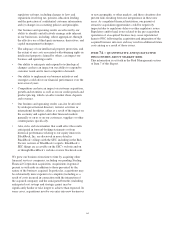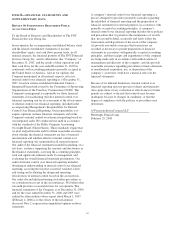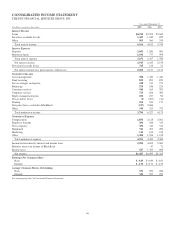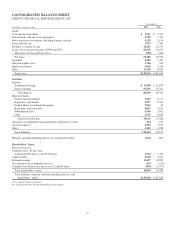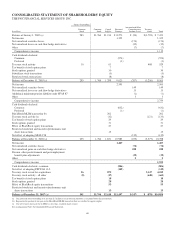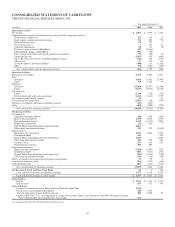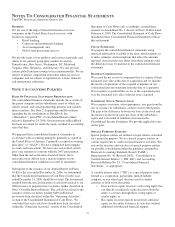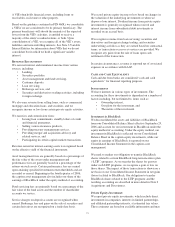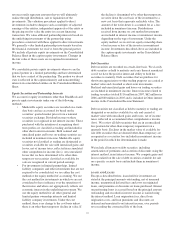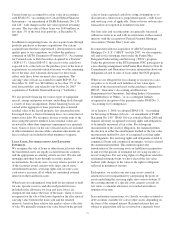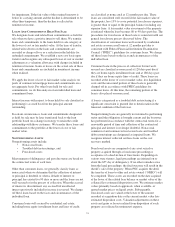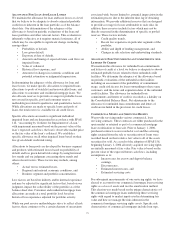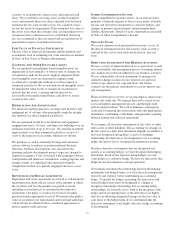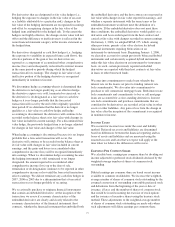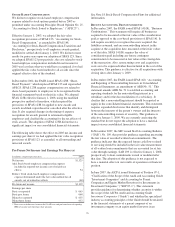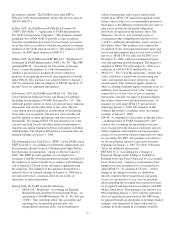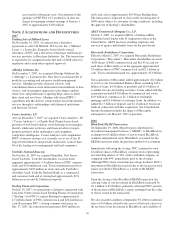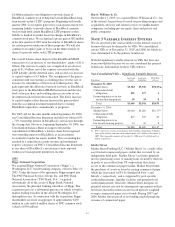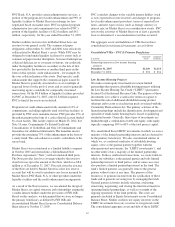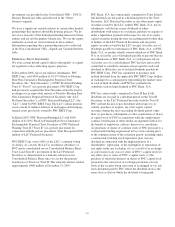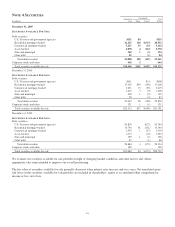PNC Bank 2007 Annual Report Download - page 79
Download and view the complete annual report
Please find page 79 of the 2007 PNC Bank annual report below. You can navigate through the pages in the report by either clicking on the pages listed below, or by using the keyword search tool below to find specific information within the annual report.for impairment. If the fair value of the retained interests is
below its carrying amount and the decline is determined to be
other-than-temporary, then the decline is reflected in
noninterest income.
L
OANS
A
ND
C
OMMITMENTS
H
ELD
F
OR
S
ALE
We designate loans and related loan commitments as held for
sale when we have a positive intent to sell them. We transfer
loans and commitments to the loans held for sale category at
the lower of cost or fair market value. At the time of transfer,
related write-downs on the loans and commitments are
recorded as charge-offs or as a reduction in the liability for
unfunded commitments. We establish a new cost basis upon
transfer and recognize any subsequent lower of cost or market
adjustment as a valuation allowance with charges included in
noninterest income. Gains or losses on the actual sale of these
loans and commitments are included in noninterest income
when realized.
We apply the lower of cost or fair market value analysis on
pools of commercial mortgage loans and commitments on a
net aggregate basis. For other loans held for sale and
commitments, we do this analysis on an individual loan and
commitment basis.
Interest income with respect to loans held for sale classified as
performing is accrued based on the principal amount
outstanding.
In certain circumstances, loans and commitments designated
as held for sale may be later transferred back to the loan
portfolio based on a change in strategy to retain the credit
relationship with those customers. We transfer these loans and
commitments to the portfolio at the lower of cost or fair
market value.
N
ONPERFORMING
A
SSETS
Nonperforming assets include:
• Nonaccrual loans,
• Troubled debt restructurings, and
• Foreclosed assets.
Measurement of delinquency and past due status are based on
the contractual terms of each loan.
Other than consumer loans, we generally classify loans as
nonaccrual when we determine that the collection of interest
or principal is doubtful or when a default of interest or
principal has existed for 90 days or more and the loans are not
well-secured or in the process of collection. When the accrual
of interest is discontinued, any accrued but uncollected
interest previously included in income is reversed. We charge
off these loans based on the facts and circumstances of the
individual loan.
Consumer loans well-secured by residential real estate,
including home equity installment loans and lines of credit,
are classified as nonaccrual at 12 months past due. These
loans are considered well secured if the fair market value of
the property, less 15% to cover potential foreclosure expenses,
is greater than or equal to the principal balance including any
superior liens. A fair market value assessment of the property
is initiated when the loan becomes 80 to 90 days past due. The
procedures for foreclosure of these loans is consistent with our
general foreclosure process discussed below. The
classification of consumer loans well-secured by residential
real estate as nonaccrual loans at 12 months past due is
consistent with Federal Financial Institutions Examination
Council (“FFIEC”) guidelines for consumer loans. We charge
off these loans based on the facts and circumstances of the
individual loan.
Consumer loans in the process of collection but not well-
secured are classified as nonaccrual at 120 days past due if
they are home equity installment loans and at 180 days past
due if they are home equity lines of credit. These loans are
recorded at the lower of cost or market value, less liquidation
costs and the unsecured portion of these loans is generally
charged off in accordance with FFIEC guidelines for
consumer loans. At this time, the remaining portion of the
loan is also placed on nonaccrual.
A loan is categorized as a troubled debt restructuring if a
significant concession is granted due to deterioration in the
financial condition of the borrower.
Nonperforming loans are generally not returned to performing
status until the obligation is brought current and the borrower
has performed in accordance with the contractual terms for a
reasonable period of time and collection of the contractual
principal and interest is no longer doubtful. Nonaccrual
commercial and commercial real estate loans and troubled
debt restructurings are designated as impaired loans. We
recognize interest collected on these loans on the cost
recovery method.
Foreclosed assets are comprised of any asset seized or
property acquired through a foreclosure proceeding or
acceptance of a deed-in-lieu of foreclosure. Depending on
various state statutes, legal proceedings are initiated on or
about the 65th day of delinquency. If no other remedies arise
from the legal proceedings, the final outcome will result in the
sheriff’s sale of the property. When PNC acquires the deed,
the transfer of loans to other real estate owned (“OREO”) will
be completed. These assets are recorded on the date acquired
at the lower of the related loan balance or market value of the
collateral less estimated disposition costs. We estimate market
values primarily based on appraisals, when available, or
quoted market prices on liquid assets. Subsequently,
foreclosed assets are valued at the lower of the amount
recorded at acquisition date or the current market value less
estimated disposition costs. Valuation adjustments on these
assets and gains or losses realized from disposition of such
property are reflected in noninterest expense.
74


